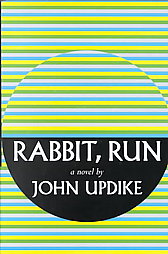Rabbit, Run
 First edition cover | |
| Author | John Updike |
|---|---|
| Country | United States |
| Language | English |
| Genre | Fiction |
| Publisher | Knopf |
Publication date | November 12, 1960 |
| Media type | Print (Hardcover and Paperback) |
| Pages | 320 pp |
| ISBN | ISBN 0394442067 Parameter error in {{ISBNT}}: invalid character |
| Followed by | Rabbit Redux |
Rabbit, Run is a 1960 novel by John Updike. It depicts three months in the life of a 26-year-old former basketball player named Harry 'Rabbit' Angstrom, and his attempts to escape the constraints of his life. It spawned several sequels, including Rabbit Redux, Rabbit Is Rich and Rabbit At Rest, as well as a related 2001 novella, Rabbit Remembered.
Plot summary
Template:Spoiler Harry "Rabbit" Angstrom is 26, married to Janice his high school girlfriend who drinks heavily, and has a two-year-old son named Nelson as well as a job selling kitchen gadgets in a small town named Mount Judge, Pennsylvania. He believes that his marriage is a failure and that something is missing from his life. Having been a basketball star in high school, Harry finds middle-class family life unsatisfying. On the spur of the moment, he decides to drive south in an attempt to escape. He soon turns around to return home, however, where after a short night's sleep he visits his old basketball coach, Marty Tothero.
Tothero introduces Rabbit to Ruth Leonard, who is a part-time prostitute, and they begin a three month affair. During this time, Janice moves back into her parents' house. Rabbit, jealous of a past fling between Ruth and a local man, forces Ruth into submitting to fellatio (presented here as a degrading sex act), and on the same night Janice goes into labor. Rabbit leaves Ruth and rushes to the hospital.
Janice gives birth to a baby girl, whom she and Rabbit name Rebecca June. Rabbit returns to live with his wife, and accepts a job at his father-in-law's car dealership. Rabbit attends church one morning, and fueled by the flirtacious overtones of the minister's wife, he tries to get his wife to have sex with him. When she refuses, and makes a comment about the "whore" that Rabbit lived with for 3 months, Rabbit runs out. The next morning Janice, while drunk and afraid that Rabbit has left for good, drowns their infant daughter in the bath. When Rabbit returns for the funeral, he refuses to take the blame for the baby's death, ultimately running away once more. He returns to Ruth and finds her pregnant. She puts forward an ultimatum: file for divorce or she will get an abortion. Unable to make a decision, Rabbit runs away once more, leaving the novel's ending in midair.
Literary influences
- Previously, Updike had written a short story entitled Ace In The Hole, and to a lesser extent a poem, Ex-Basketball Player, with similar themes to Rabbit Run.[1]
- Protagonist Rabbit's name was inspired by Beatrix Potter's children story The Tale of Peter Rabbit.[citation needed]
- John Updike said that he wrote Rabbit, Run in response to Jack Kerouac's On the Road, and tried to depict "what happens when a young American family man goes on the road – the people left behind get hurt."[2]
- To a lesser extent, echoes of J.D. Salinger's The Catcher in the Rye can also be found.[3]
Present tense
The novel is credited to be one of the first novels to use the present tense in its narration. Updike stated that "in Rabbit, Run, I liked writing in the present tense. You can move between minds, between thoughts and objects and events with a curious ease not available to the past tense. I don't know if it is clear to the reader as it is to the person writing, but there are kinds of poetry, kinds of music you can strike off in the present tense."[4]
Textual note
The text of the novel went through several rewrites. Knopf originally required Updike to cut some "sexually explicit passages," but he restored and rewrote the book for the 1963 Penguin edition and again for the 1995 Everyman's omnibus edition.[5]
Film
In 1970, the novel was made into a film directed by Jack Smight. The script was co-written by Updike and Howard B. Kreitsek.[6][7] The poster reads, "3 months ago Rabbit Angstrom ran out to buy his wife cigarettes. He hasn't come home yet." [8]
References
- ^ Interview with John Updike at Penguin Classics
- ^ Interview with John Updike at Penguin Classics
- ^ You Cannot Really Flee: By David Boroff New York Times article, Nov 6, 1960 pg. BR4
- ^ "The Art of Fiction", John Updike
- ^ John Updike, "Introduction" to Updike, Rabbit Angstrom: A Tetralogy (New York: Knopf, 1995), p. ix.
- ^ IMDB page for the film adaptation
- ^ New York Times Movies entry for the film adaptation
- ^ The Internet Movie Poster Awards: Rabbit, Run
